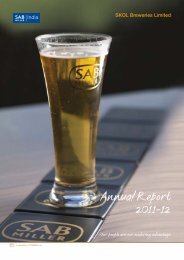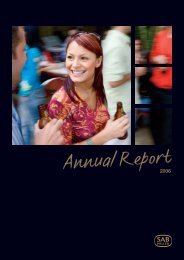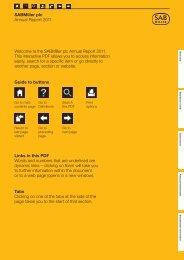Annual Report - SABMiller India
Annual Report - SABMiller India
Annual Report - SABMiller India
- No tags were found...
You also want an ePaper? Increase the reach of your titles
YUMPU automatically turns print PDFs into web optimized ePapers that Google loves.
1. Accounting policies continuedDeferred tax is provided in full using the liability method, in respectof all temporary differences arising between the tax bases ofassets and liabilities and their carrying values in the consolidatedfinancial statements, except where the temporary difference arisesfrom goodwill or from the initial recognition (other than a businesscombination) of other assets and liabilities in a transaction thataffects neither accounting nor taxable profit.Deferred tax liabilities are recognised where the carrying valueof an asset is greater than its tax base, or where the carryingvalue of a liability is less than its tax base. Deferred tax isrecognised in full on temporary differences arising from investmentin subsidiaries and associates, except where the timing of thereversal of the temporary difference is controlled by the groupand it is probable that the temporary difference will not reversein the foreseeable future. This includes taxation in respect ofthe retained earnings of overseas subsidiaries only to the extentthat, at the balance sheet date, dividends have been accruedas receivable or a binding agreement to distribute past earningsin future periods has been entered into by the subsidiary. Deferredincome tax is also recognised in respect of the unremitted retainedearnings of overseas associates as the group is not able todetermine when such earnings will be remitted and when suchadditional tax such as withholding taxes might be payable.A net deferred tax asset is regarded as recoverable and thereforerecognised only when, on the basis of all available evidence, it isprobable that future taxable profit will be available against whichthe temporary differences (including carried forward tax losses)can be utilised.Deferred tax is measured at the tax rates expected to applyin the periods in which the timing differences are expected toreverse based on tax rates and laws that have been enactedor substantively enacted at balance sheet date. Deferred tax ismeasured on a non-discounted basis.v) Dividend distributionsDividend distributions to equity holders of the parent arerecognised as a liability in the group’s financial statements inthe period in which the dividends are approved by the company’sshareholders. Interim dividends are recognised when approvedby the board. Dividends declared after the balance sheet date arenot recognised, as there is no present obligation at the balancesheet date.w) Employee benefits(i) Wages and salariesWages and salaries for current employees are recognised inthe income statement as the employees’ services are rendered.(ii) Vacation and long-term service awards costsThe group recognises a liability and an expense for accruedvacation pay when such benefits are earned and not whenthese benefits are paid.The group also recognises a liability and an expense for long-termservice awards where cash is paid to the employee at certainmilestone dates in a career with the group. Such accruals areappropriately discounted to reflect the future payment datesat discount rates determined by reference to local high qualitycorporate bonds.(iii) Profit-sharing and bonus plansThe group recognises a liability and an expense for bonuses andprofit-sharing, based on a formula that takes into considerationthe profit attributable to the company’s shareholders after certainadjustments.The group recognises a provision where contractually obligedor where there is a past practice that has created a constructiveobligation. At a mid year point an accrual is maintained for theappropriate proportion of the expected bonuses which wouldbecome payable at the year end.(iv) Share-based compensationThe group operates a variety of equity-settled, share-basedcompensation plans. These comprise share option plans (withand without non-market performance conditions attached) anda performance share award scheme (with market conditionsattached). An expense is recognised to spread the fair valueof each award granted after 7 November 2002 over the vestingperiod on a straight-line basis, after allowing for an estimate ofthe share awards that will eventually vest. This expense is offsetby a corresponding adjustment made to equity over the remainingvesting period. The estimate of the level of vesting is reviewedat least annually, with any impact on the cumulative charge beingrecognised immediately. The charge is based on the fair valueof the award as at the date of grant, as calculated by variousbinomial model calculations and Monte Carlo simulations.The charge is not reversed if the options are not exercisedbecause the market value of the shares is lower than the optionprice at the date of grant.The proceeds received net of any directly attributable transactioncosts are credited to share capital (nominal value) and sharepremium when the options are exercised.(v) Pension obligationsThe group has both defined benefit and defined contribution plans.The liability recognised in the balance sheet in respect of definedbenefit pension plans is the present value of the defined benefitobligation at the balance sheet date less the fair value of planassets, together with adjustments for unrecognised past servicecosts. The defined benefit obligation is calculated annually byindependent actuaries using the projected unit credit method.The present value of the defined benefit obligation is determinedby discounting the estimated future cash outflows using interestrates of high-quality corporate bonds that are denominated in thecurrency in which the benefits will be paid, and that have terms tomaturity approximating to the terms of the related pension liability.Actuarial gains and losses arising from experience adjustmentsand changes in actuarial assumptions are recognised in full asthey arise outside of income statement and are presented in thestatement of recognised income and expense, with the exceptionof gains or losses arising from changes in the benefits regardingpast services, which are recognised in the income statement.Past-service costs are recognised immediately in the incomestatement, unless the changes to the pension plan are conditionalon the employees remaining in service for a specified period oftime. In this case, the past-service costs are amortised on astraight-line basis over the vesting period.The contributions to defined contribution plans are recognisedas an expense as the costs become payable. The contributionsare recognised as employee benefit expense when they are due.Prepaid contributions are recognised as an asset to the extentthat a cash refund or a reduction in the future paymentsis available.(vi) Other post-employment obligationsSome group companies provide post-retirement healthcarebenefits to qualifying employees. The expected costs of thesebenefits are assessed in accordance with the advice of qualifiedactuaries and contributions are made to the relevant funds overthe expected service lives of the employees entitled to thoseOverview Operating and financial review Governance Financial statements Shareholder informationNotes to the consolidated financial statements 73<strong>SABMiller</strong> plc <strong>Annual</strong> <strong>Report</strong> 2008













